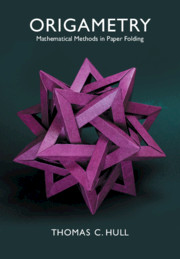Book contents
- Frontmatter
- Dedication
- Contents
- Introduction
- Part I Geometric Constructions
- Part II The Combinatorial Geometry of Flat Origami
- 5 Flat Vertex Folds: Local Properties
- 6 Multiple-Vertex Flat Folds: Global Properties
- 7 Counting Flat Folds
- 8 Other Flat-Folding Problems
- Part III Algebra, Topology, and Analysis in Origami
- Part IV Non-flat Folding
- References
- Index
6 - Multiple-Vertex Flat Folds: Global Properties
from Part II - The Combinatorial Geometry of Flat Origami
Published online by Cambridge University Press: 06 October 2020
- Frontmatter
- Dedication
- Contents
- Introduction
- Part I Geometric Constructions
- Part II The Combinatorial Geometry of Flat Origami
- 5 Flat Vertex Folds: Local Properties
- 6 Multiple-Vertex Flat Folds: Global Properties
- 7 Counting Flat Folds
- 8 Other Flat-Folding Problems
- Part III Algebra, Topology, and Analysis in Origami
- Part IV Non-flat Folding
- References
- Index
Summary
Chapter 6 covers global flat foldability.This includes determining how we can tell if a crease pattern with multiple vertices will fold flat without forcing the paper to self-intersect, as well as discovering properties that all such crease patterns have, beyond what was covered in the previous chapter.Justin’s Theorem, which is a generalization of Kawasaki’s and Maekawa’s Theorems and whose proof uses elements of basic knot theory, is covered, as are Justin’s non-crossing conditions that provide necessary and sufficient conditions for a general crease pattern to fold flat.The matrix model from Chapter 5 is developed further to create a formal folding map for flat origami.Finally, Bern and Hayes’ seminal proof that determining flat foldability of a given crease pattern is NP-Hard is presented and updated with more recent results on box pleating.
Keywords
- Type
- Chapter
- Information
- OrigametryMathematical Methods in Paper Folding, pp. 107 - 136Publisher: Cambridge University PressPrint publication year: 2020

